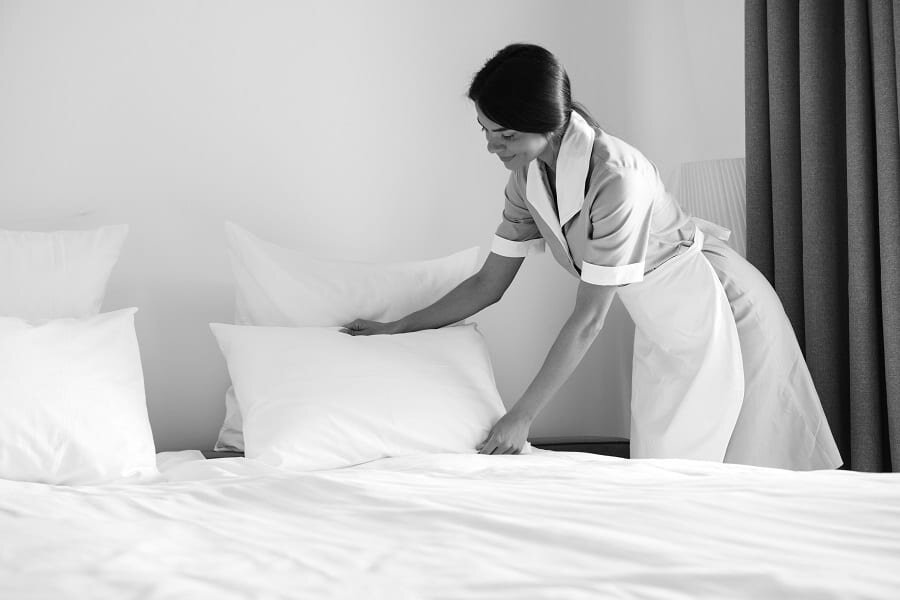Workplace Safety Hazards for Hospitality & Hotel Workers
Most duties of housekeepers in the hospitality industry are intense and grueling. Hotels today are competitive and offer more amenities to their guest and as a result, in an increase of workload and unseen safety hazards that can lead to an increase of serious workplace injury. Data from The Bureau of Labor Statistics from 2017 shows that hotel and motel workers had a nonfatal injury and illness incidence rate of 4.3 while total record-able cases of all industries including private, state, and local government are 3.1. Safety agencies are reporting a significant increase in occupational injuries, safety hazards, and diseases among hospitality employees. Safety advocates are proposing proper training and safety procedures that can teach housekeeping staff how to prevent muscle drain to the body, and provide proper preventative measures and procedures to prevent violence in the workplace.
Common hazards and injuries for hospitality workers
Hotel housekeeping staff is a very physically demanding job that includes many, varied tasks including, vacuuming, dusting, changing linens, and making beds. Housekeeping staff is subject to turning over mattresses that can sometimes weigh more than 100 pounds while daily cleaning and scrubbing of bathrooms can expose health risks with chemicals used in cleaning products. As a result, housekeeping hotel employment could lead to any of the following injuries and safety hazards:
Slips and falls: Scrubbing floors of bathtubs, showers in bathroom floors create ideal conditions for slip-and-fall accidents.
Respiratory: Exposure to chemical cleaning agents that can cause long-term respiratory problems.
Infectious diseases: Waste disposal can expose hotel housekeeping staff to pathogens, broken glass, and other body waste.
Stress: Excessive workload and exposure to other hazards can cause occupational stress.
Muscle Injuries: Repetitive movements of vacuuming, scrubbing, dusting, etc. of hotel rooms require housekeeping staff to move their body in ways that can strain and even tear muscles and tendons.
Harassment and violence: An increasing amount of workplace harassment and violence has been reported in hotels across Canada and the United States. Violence and harassment can be defined as any act in which a person is abused, threatened, intimidated or assaulted in his or her employment.
Sadly, violence and sexual harassment with hotel and hospitality workers are becoming bigger and more significant problems within the industry. Thankfully, major hotel chains are taking this safety hazard seriously and are taking big steps like the 5-Star Promise from the American Hotel and Lodging Association.
Suggested precautions for hospitality workers
Safety authorities suggest hotel cleaners take the following precautions for their workers:
Muscle Injuries –To prevent unnecessary muscle tension, workers are encouraged to ask for help from co-workers if they need to lift heavy mattress to avoid and injuries while changing linens and making beds or moving heavy furniture. Staff is encouraged to switch arms to avoid overexertion of muscles and tendons of one arm
Take Regular Breaks – Hotel shifts can be long and exhausting; employees are encouraged to stretch and take regular breaks.
Preventative Technology: Hotel housekeeping workers are considered lone workers, and employers are responsible for the health and safety of workers, including procedures or a system in place to ensure workers are safe when working alone while cleaning rooms.
Safety check-ins and the panic button mandate
In some states of the United States, safety bills have been proposed to help protect hotel housekeeping and room service workers against assaults and harassment. The state of New Jersey was the first in the country that requires hotel employees to provide a hotel panic button device to all employees who are assigned to work in a guest room without co-workers present, according to Senate, No. 2986. When the panic button device is activated, a staff member, manager, or security officer must respond immediately to the workers’ location. This law went into effect in January 2020, and the law applies to all hotels in the state of New Jersey that has more than 100 guest rooms.
In 2012, in Victoria, British Columbia, a hotel worker was assaulted, tied up, and robbed in the early hours of the morning. This disturbing event is an example of the safety hazards of working alone during the late and early hours of the morning. In BC, Canadian employers are required to develop a working alone policy and procedure, including a working alone monitoring device or lone worker safety device to check the well-being of workers at predetermined intervals. An extra feature such as a panic button device can trigger an alarm and expedite help when it is needed.
Conclusion
Does your workplace have any people who may work alone or in isolation outside of visual or auditory contact from other workers? These “lone workers” have a unique set of risks and their workplace hazard assessment should be treated differently. If your workplace does have lone workers, call 1-888-WRK-ALNE or contact us by email for a specialized consultation regarding the safety of your lone workers. The SafetyLine Lone Worker app is used while working alone or in isolation and allows you to check in to update your workers’ status, record detailed messages, and report location with GPS. Workers check into the app regularly to report that they’re safe. If the worker misses a check-in or indicates an emergency, SafetyLine will call for help. During emergencies, designated monitors receive automated phone calls and emails from SafetyLine, and are provided with online tools for emergency response. If you think your workplace may have people working alone and safety hazards, but are not sure about the exact working alone structure, check out this article on the definitions of lone workers.

